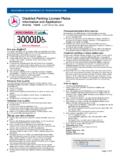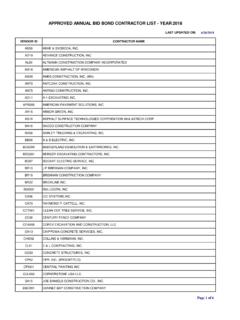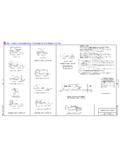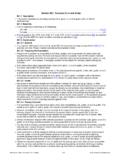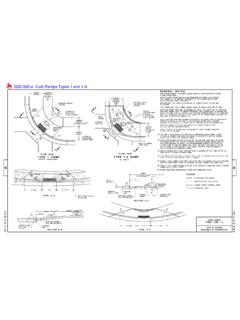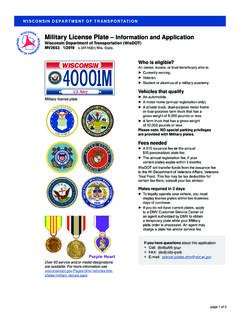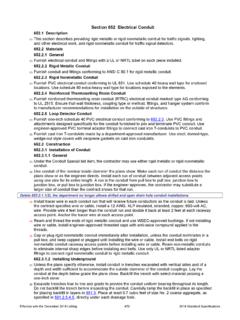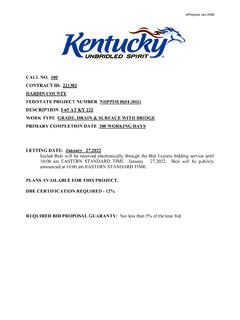Transcription of 628 Erosion Control - Wisconsin Department of Transportation
1 Section 628 Erosion Control Description (1) This section describes providing Erosion Control mats, bale checks or dikes, fences, screens, blankets, and other Erosion Control devices. (2) This section also describes cleaning sediment basins and mobilizations for Erosion Control . Materials General Acronyms (1) Interpret acronyms used throughout this section as follows: Revise (1) to delete the local acronym for the Department 's approved products list now a global acronym under (3) and provide links to the PAL website. ECRM Class I, II, and IIIA Erosion Control revegetative mats. TRM Class III B, C, and D turf reinforcement mats. Product Acceptability (1) The Department prequalifies selected Erosion Control products in the Department 's PAL.
2 If the contract specifies, furnish products of the class, type, and subject to the seasonal limitations the Department 's PAL designates. Before installing a product from the Department 's PAL, submit to the engineer a written copy of the manufacturer's specifications for installing that product on slopes, channels, shorelines, high wind locations, and next to live traffic lanes as applicable to the contract installation. Install products from the Department 's PAL conforming to those manufacturer's specifications. The Department may specify modifications to the manufacturer's procedures for individual materials here within 628. (2) The Department may sample and test products supplied in the field to verify that they conform to the Department 's PAL prequalification requirements.
3 Provide samples as the engineer directs. Erosion Mat (1) The Department must prequalify all Erosion mat products before use. Furnish Erosion mat products from the Department 's PAL. (2) The Department 's PAL identifies prequalified Erosion mat products by class and type. Use the required class and type of Erosion mat the plans show or the engineer specifies. The contractor may furnish any prequalified Erosion mat product of the class and type the plans show or that the engineer specifies. (3) If using jute fabric for a Class II Type A Erosion mat, use a woven fabric of a uniform open weave of single jute yarn. Use a jute yarn of loosely twisted construction with an average twist of not less than 1.
4 1/2 turns per one inch. Ensure the average size of the warp and weft yarns are approximately the same. Furnish the woven fabric in rolled strips. Submit a certificate of compliance certifying that the jute fabric Erosion mat conforms to the following: - Is a minimum 48 inches wide with a tolerance of minus one inch. - Has 78 warp ends, +/- one for each 48 inches of width. Has 45 weft yarns, +/- 2, per linear yard of length. - Weighs 92 pounds per 100 square yards +/- 10 percent, measured under average atmospheric conditions. - Is non-toxic to vegetation. Staples (1) Furnish U-shaped staples, made of No. 11 or larger diameter steel wire, or other engineer-approved material, are one to 2 inches wide, and not less than 6 inches long for firm soils and not less than 12.
5 Inches for loose soils. The contractor may use anchors the staple gun manufacturer recommends, either lighter gage staples or equivalent, for engineer-approved staple gun systems. Bales (1) For bales, use straw, hay, or other engineer-approved material, in good condition, of the dimensions the plans show. Stakes (1) Furnish wood or metal stakes of the dimensions the plans show. Effective with the December 2017 Letting 385 2018 Standard Specifications Silt Fence Geotextile (1) Furnish one of the following geotextiles: woven or non-woven polyester, polypropylene, stabilized nylon, polyethylene, or polyvinylidene chloride. For non-woven fabric the contractor may use needle punched, heat bonded, resin bonded, or combinations of all 3.
6 Submit a certificate of compliance certifying that the geotextile conforms to the following: TEST REQUIREMENT METHOD VALUE[1]. Minimum grab tensile strength ASTM D4632 120 lb (machine direction). Minimum grab tensile strength ASTM D4632 100 lb (cross machine direction). Maximum apparent opening size ASTM D4751 No. 30. (equivalent standard sieve). Minimum Permittivity ASTM D4491 s-1. Minimum ultraviolet stability ASTM D4355 70%. (strength retained at 500 hrs of exposure). [1] All numerical values represent minimum or maximum average roll values. Average test results from all rolls in a lot must conform the tabulated values. Fence Support System (1) Conform to plan requirements.
7 Silt Screen (1) Furnish fabric and submit a certificate of compliance certifying that the fabric conforms to the following: Thickness .. 15 mils Minimum grab tensile strength .. 120 lb Minimum equivalent opening .. sieve (2) Heat seal or sew all fabric seams. (3) For flotation, use an 8-inch diameter solid expanded polystyrene log, or engineer-approved equal, with a buoyancy of approximately 20 pounds per foot. Do not use polystyrene beads or chips. (4) For the main load line, use 5/16-inch cable. For ballast, use a 1/4-inch chain. Sand Bags (1) Furnish bags made of canvas, burlap, nylon, or other engineer-approved material filled with concrete sand or other engineer-approved granular material.
8 Polyethylene Sheeting (1) Furnish 6 mil or thicker polyethylene sheeting conforming to ASTM D4397. Turbidity Barriers (1) Furnish barrier made of coated impervious fabric capable of containing all sediment at the location placed. It shall have a cable, with a 5/16 inch or larger diameter, capable of supporting the barrier at the required height above the water. It shall have a self-contained ballast that weighs at least pound per foot. The ballast may be either chain or flexible cable. Barrier ends shall have grommets to lace together adjoining sections. For anchor posts use one of the following: steel fence posts, steel pipes, or steel channels.
9 (2) Submit a certificate of compliance certifying that the turbidity barrier fabric conforms to the following: TEST REQUIREMENT METHOD VALUE[1]. Minimum grab tensile strength ASTM D4632 200 lb Minimum puncture strength ASTM D4833 90 lb Maximum permeability ASTM D4491 1x10-7 cm/s Minimum ultraviolet stability ASTM D4355 70%. (strength retained at 500 hrs of exposure). [1] All numerical values represent minimum or maximum average roll values. Average test results from all rolls in a lot must conform the tabulated values. Soil Stabilizer (1) Soil stabilizer type A is one of the following: a cementitious soil binder added to wood cellulose fiber mulch, or a bonded fiber matrix.
10 Soil stabilizer type B is a polyacrylimide. Effective with the December 2017 Letting 386 2018 Standard Specifications (2) Furnish soil stabilizer products from the Department 's PAL. Inlet Protection (1) Use a type FF geotextile conforming to except use a woven polypropylene fabric. Furnish type FF geotextiles, or bags manufactured from type FF geotextiles, from the Department 's PAL. Rock Bags (1) Furnish rock bags made of a porous, ultraviolet resistant, high-density polyethylene or geotextile that will retain 70 percent of its original strength after 500 hours of exposure according to ASTM D4355. and a minimum in-place filled size of 18 inches long by 12 inches wide by 6 inches high.

